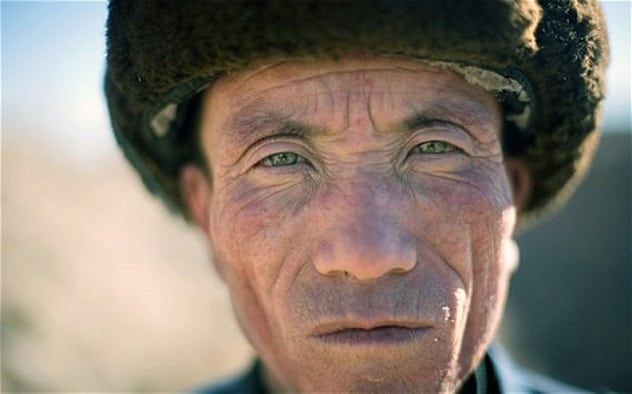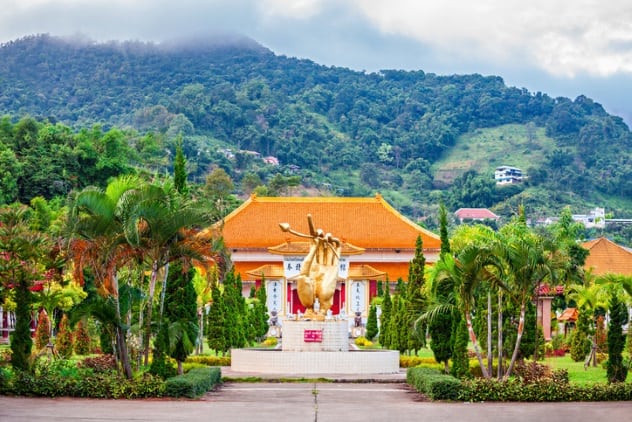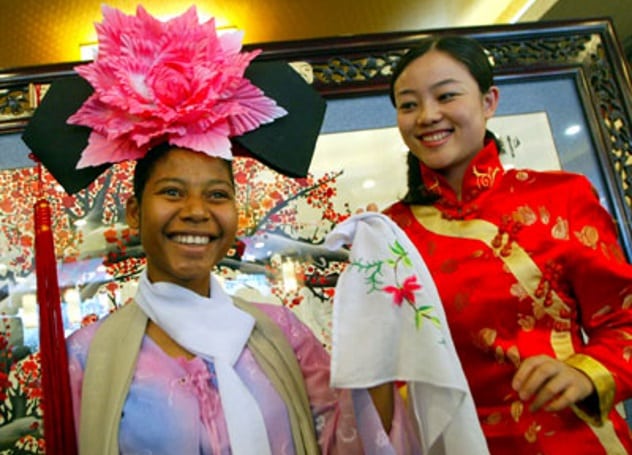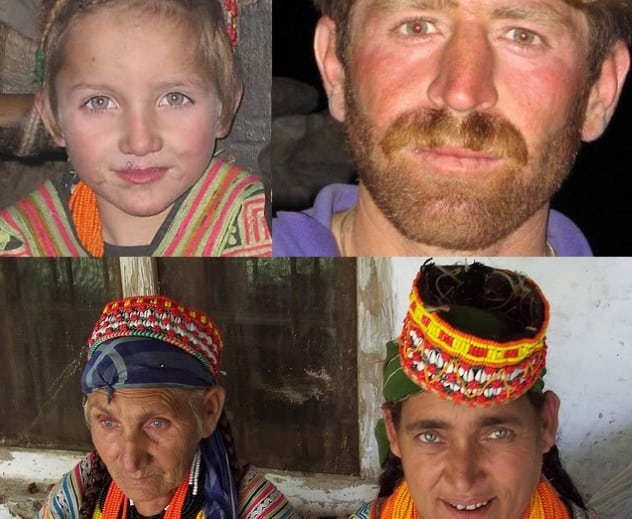Human history is a long narrative of the rise and fall of nations, empires, and the peoples that inhabit them. Yet while empires fall, rebellions are crushed, and cultures are lost to time, tiny remnants sometimes survive—precariously—across history. Here are ten examples that will surprise you.
10 The Lost Legionaries Of China
Contact between the Roman Empire and Han dynasty China was limited, yet there is evidence to suggest that villagers in the remote Chinese county of Liqian are the descendants of Roman soldiers lost 2,000 years ago. The theory was proposed by Oxford professor Homer Dubbs after he examined ancient Chinese accounts of a battle in 36 BC on China’s western frontier with nomadic barbarians, the Hsiung-Nu (or Xiongnu).[1] In this battle, more than 100 men fighting for the Hsiung-Nu used a “fish scale” formation—similar to the Roman testudo formation and uncharacteristic of such Nomadic peoples. Dubbs noted that 17 years earlier, some 10,000 Romans had been captured by the Parthians at the disastrous Battle of Carrhae. Historical records reveal that the prisoners were moved to Parthia’s eastern frontier, close to China’s western border. (Parthia occupied what is now Iran.) Dubbs believed that these men may have become mercenaries, fighting for the Hsiung-Nu before being captured and used by the Chinese to defend their frontier. He believes they founded a frontier town named Li-Jien (also spelled Li-Chien), a name which sounds remarkably similar to “Legion.” To this day, many of the villagers in Liqian have blue or green eyes and fair hair. A 2010 genetic study revealed that 56 percent of their DNA is Caucasian in origin. Despite this, the theory remains controversial.
9 The Thai Villages Founded By Exiled Chinese Soldiers
When the Chinese nationalists were defeated by the communists under Mao Tse-tung in 1949, many fled to Taiwan. However, the 93rd Division retreated into Myanmar (Burma), where, during the Cold War, they fought against the Burmese government and ethnic militias and, with the help of Taiwan and the US government, continued to launch attacks into China itself. Eventually, they ended up in Northern Thailand, where they established over 60 villages which still exist today. Allowed to stay after they assisted the Thai government in its conflict against communists, they were gifted citizenship in the 1980s, on the condition that they put down their arms and take up farming. To this day, the villages retain their Chinese identity and culture and have become a tourist attraction for Thais looking to experience Chinese culture.[2]
8 The ‘Confederate Colonies’ Of Brazil
When the Confederacy was defeated in the US Civil War, Emperor Dom Pedro II of Brazil, a staunch ally of the Confederate cause, welcomed Confederate soldiers and sympathizers wishing to start a new life. Thousands of Southerners, motivated by a hate of the wartime enemy and an instinctive urge to preserve Southern cultural values, flocked to Brazil. Although Brazil was the last country in the Americas to ban slavery (not doing so until 1888), the preservation of Southern culture was the primary motivator for the emigrants.[3] Indeed, to this day, throughout towns in Brazil, the Confederacy and Southern US culture is celebrated annually by the thousands of descendants of these Americans, known locally as Confedorados, many of whom now have non-white and African heritage. Square dances are held, and confederate flags are flown proudly, racial connotations long lost amid the sea of racial diversity in Brazil.
7 The Kenyans Descended From 15th-Century Chinese Sailors
In the 15th century, the Chinese explorer Zheng He was sent on an expedition to the eastern coast of Africa to spread Chinese culture, signal Chinese strength, and establish tributary states on the continent. However, several of his ships were sunk near Lamu Island, Kenya, in 1415. Local oral tradition maintains that 20 Chinese survivors washed ashore there. After killing a dangerous python, they were given permission to stay by the locals.[4] They allegedly converted to Islam and married local women, and their descendants continue to reside on the island to this day. In 2005, a young descendant of these sailors was awarded a scholarship to study in China. This was not an isolated case, either. Some tribes in Cape Town’s north claim descent from Chinese sailors as far back as the 13th century. With paler skin and a Mandarin-sounding tonal language, they call themselves the Awatwa, meaning “abandoned people.” There is also archaeological evidence; Chinese ceramics are present in both locations, allegedly brought by these abandoned sailors.
6 The Lost Jewish Tribes In Africa
The Bible alleges that there were once 12 tribes of Israel, each founded by a son of Jacob. Ten of these tribes went “missing” after an invasion of their homeland by the Assyrians in 721 BC. The Lemba tribe, living in South Africa and Zimbabwe, claim that their ancestors were Jews who fled the Holy Land at this time. Though many are now Christian, their cultural traditions remain remarkably similar to those of the Jews—they abstain from eating pork, practice male circumcision, ritually slaughter animals, and put the Star of David on their gravestones. Some of the men even wear skullcaps. In 2010, a British study discovered that the tribe shares genetic ancestry with Jews. Intriguingly, the members of the priestly class of the Lemba have a gene found only among the Jewish priestly line, sharing a common ancestor some 3,000 years ago, when the priesthood started.[5] The sacred prayer language of the Lemba is a mix of Hebrew and Arabic, further reinforcing the evidence that they are the descendants of a lost Jewish tribe.
5 The Jewish Tribe Lost In India
like the Lemba, the Bnei Menashe people of the mountainous region around the Indian-Burmese border believe that they, too, are the descendants of Jews exiled in 721 BC. Once headhunters, the Bnei Menashe used to practice animist religions before converting to Christianity in the 19th century and finally to Judaism in the 20th century, when many of them emigrated to Israel. They do, however, retain a cultural connection with the ancient Jews, claiming descent from the Menashe tribe, named after a legendary ancestor known as Manmasi. However, the claims of Jewish heritage remain controversial, as several genetic studies have found differing results, and the evidence remains inconclusive. The current consensus is that a small group of their ancestors were descended from a “lost tribe” and spread Jewish traditions and customs to a larger group of people.[6] This may explain both the Jewish cultural roots and the lack of comprehensive genetic evidence.
4 Alexander The Great’s Legacy
Wherever Alexander took his Macedonian army, he influenced the peoples and cultures he encountered. Between 334 and 324 BC, he swept through the Persian Empire, reaching as far as the fringes of the Indian subcontinent. Some of his followers even stayed to found Indo-Greek kingdoms there, which survived for centuries until the ascension of Islam in the region. Scholars have noted the commonalities between ancient Greek and Sanskrit, and ancient Greek coins are still available at local markets. Indeed, when British administrators visited the region in the 19th century, local chieftains produced ancient Greek bowls, gifted to them by the invaders, to prove their right to rule. The Kalash people of modern-day Pakistan and Afghanistan claim descent from the Macedonian army that marched through these lands millennia ago. The Kalash worship versions of the ancient Greek gods, and unlike their Muslim neighbors, they harvest and ferment grapes, which they revere.[7]
3 Descendants Of Polish Deserters In Haiti
As the only country to form as the result of a slave rebellion, Haiti has a unique history. Haiti was a French colony, and at the time of the uprising, thousands of Poles were fighting as mercenaries for Napoleonic France. The reason was simple. Poland had been partitioned between Prussia, Russia, and Austria. Although Poland would not gain independence until 1918, many Poles believed that they could free their country by fighting with Napoleon. But when they were instead sent to fight thousands of miles from their homeland against slaves who wanted nothing more than their freedom, many either deserted or, when captured and offered the chance to switch sides, fought instead for the rebels. After the war, the Poles mixed with the locals and set up communities in the countryside, most notably the town of Cazales (aka Cazale), which retains its Polish culture to this day.[8] The fact that the Haitian government granted them the right to own land, despite the Haitian constitution explicitly banning white landowners, is evidence of the respect these men garnered among their fellow rebels.
2 The Islanders Descended From Mutineers
In 1790, nine mutineers from the British ship HMS Bounty, along with several Tahitian men and women, settled on the uninhabited Pitcairn Island after burning and sinking their ship.[9] Initially, tensions, fueled by alcoholism and disease, among other problems, resulted in several deaths within the small group. But eventually, aided by a sudden “Christian fervor,” the group managed to establish a functioning community on the island. Pitcairn became a British colony in 1838, and many of the inhabitants who were descended from the original stranded crew moved to the neighboring Norfolk Island in 1856, together with accompanying Tahitians. Despite this migration, descendants of the mutineers continue to live on Pitcairn to this day.
1 The Algerian Rebels Imprisoned On A Pacific Island
For much of the 19th and 20th centuries, Algeria was ruled by the French. However, a significant proportion of the locals didn’t particularly like this state of affairs, and in 1870, a group of them launched an armed rebellion against French rule. Unfortunately for them, they were defeated, and the leaders were imprisoned on the Pacific island of New Caledonia, which France used as a penal colony. In fact, during the course of French rule in Algeria, over 2,000 Algerians, dubbed “rebels” by the French, shared the same fate. New Caledonia, which remains a French territory to this day, was colonized in 1853, and around ten percent of its nearly 300,000-strong population can claim Algerian descent.[10] Since all the Algerian deportees were male, this community is of mixed heritage. (Numerous Algerians took exiled French women as wives.) Many of these descendants continue to feel a deep sense of resentment about their ancestors’ imprisonment and a strong connection to their Algerian roots.
























